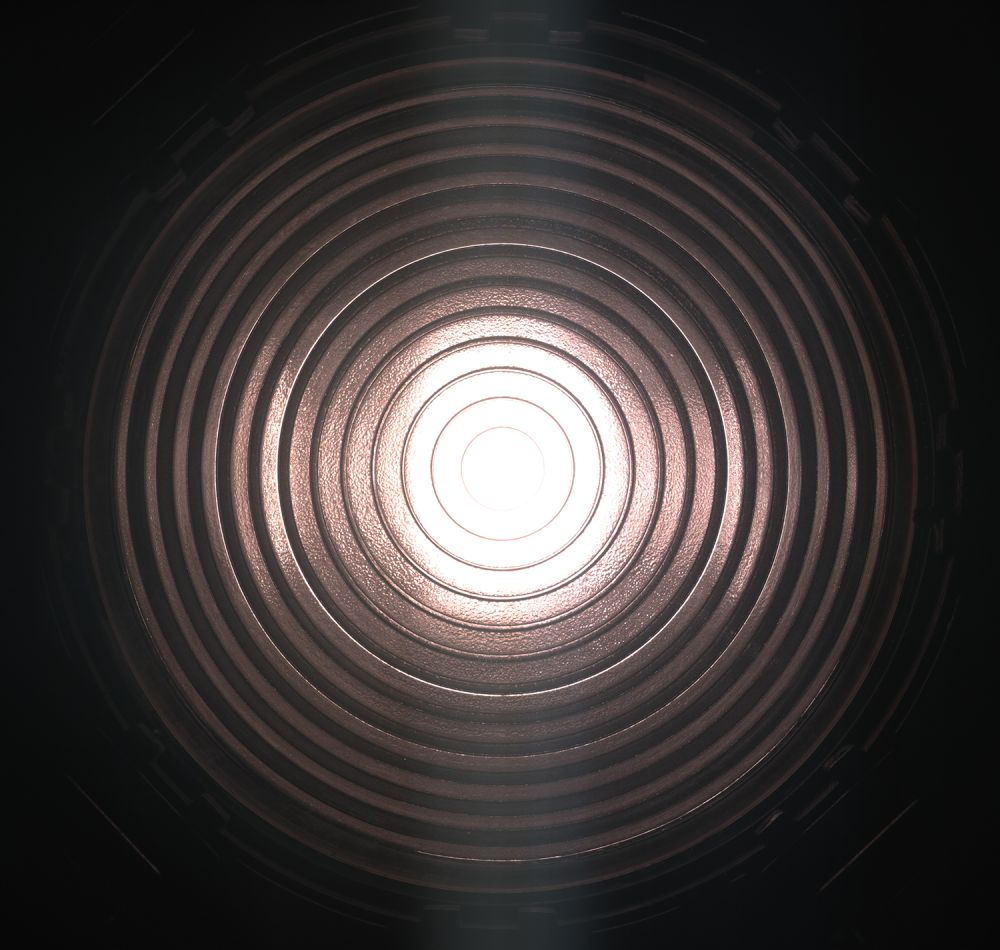"Exposure b"
C-print on Dibond
„Exposures“, 2002 ff.
Selichar's most recent photo series entitled "Exposures" is devoted to another component of devices or apparative installations of electronic image media: the lamps for illuminating/lighting the motifs or places selected for shooting pictures. These are frequently halogen lamps, such as those built into video or film cameras, camcorders or other recording devices. These light sources are photographed in color in an active, in other words illuminated state. Here again, the apparatus context is not recognizable, because the adjacent, barely captured encasing sections appear only as a black outline in the glare of the light. Thus the usually circular illuminants have the effect of being released or that of bright figures against a square, dark ground. What becomes visible here, in the sharpest possible focus, are the irregular, knot-like centers where the actual light source, the filaments are; in addition, there are valleys of shadow or gray-shaded areas around these centers, which spread out in astonishingly different forms on the spherically curved, glowing white reflectors. Yet what comes into view - literally before anything else - are the surfaces of the transparent diffusion plates that cover the bulb as protection and diffuse the light shining through them through their irregularities. Everything behind them in the photo appears to be filtered through them: slightly blurred or schematically dissolved, depending on how the surfaces of the plates are made (like looking into a bathroom through fluted glass). Since the focus is adjusted exactly to the level of these diffusion plates, their own irregularities can sometimes also be recognized. A further variation of a collision of "media" (in multiple meanings of the term) thus becomes evident here.
Aside from the appeal of the image aesthetics, in its interplay with the title the subject opens up numerous media-sociological and theoretical issues. The English term exposure covers a broad field of terminology, including the meanings: the act of subjecting someone to an influencing experience; abandoning without shelter or protection; presentation to view in an open or public manner; the act of exposing film to light; vulnerability to the elements; to the action of heat or cold or wind or rain; aspect re light or wind; the disclosure of something secret; the intensity of light falling on a photographic film or plate; the state of being vulnerable or exposed; a picture of a person or scene in the form of a print or transparent slide; recorded by a camera on light-sensitive material. In this way, aggressive, confrontational and investigative aspects of mass media culture are addressed on the one hand, but a conscious and voluntary activity and its effects on the victim side are also expressed as well.
On the other hand, the term also describes essential physical-chemical processes of photographic image production (and the media that depend on it). In a broader sense, the series "Exposures" refers to the elementary basis of every pictorial representation or mediatization, because light is the precondition for visibility at the level of visual perception. As in "Screens, cold" before, Selichar targets a complex intersection of discourses and parameters in his work with an immediately comprehensible, everyday motif.
(Marie Röbl, „Sources“, „Screens“, „Exposures“. Günther Selichars Medienanalysen im fotografischen Medium, in: Martin Hochleitner (ed.), Alexander Horwath, Marc Ries, Dieter Ronte, Marie Röbl, Birgit Sonna: Günther Selichar. Third Eye, Linz, Salzburg: OÖ.Landesgalerie, Fotohof edition 37, 2004)
